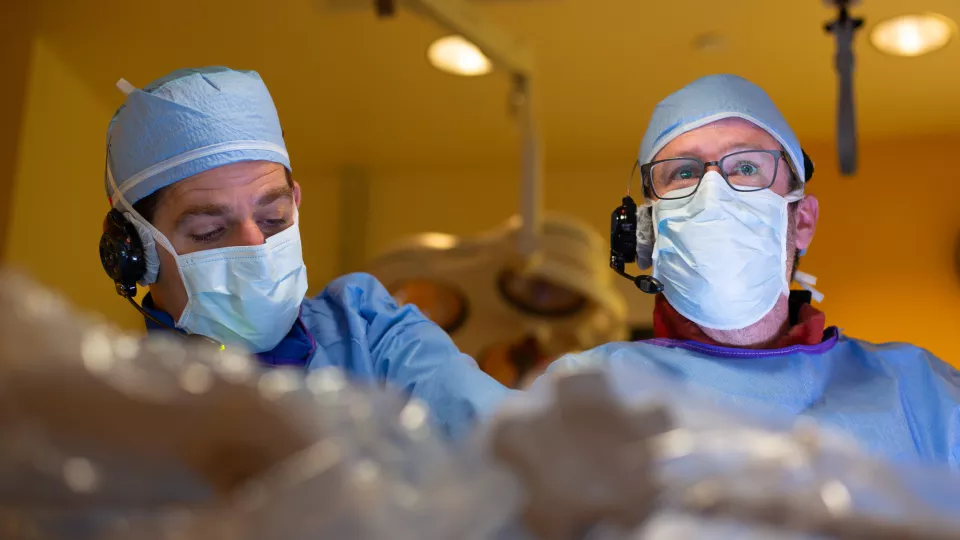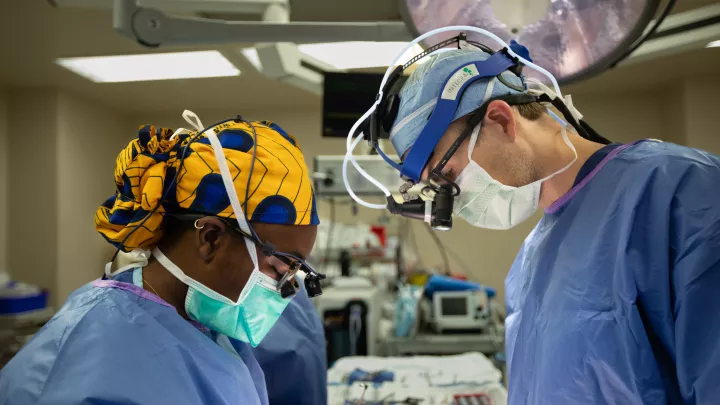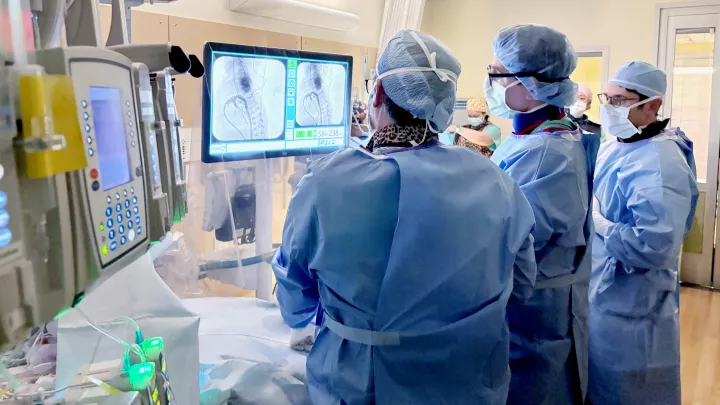
Left to right: Darren Berman, MD, and Patrick Sullivan, MD, in the Cardiac Catheterization Lab at CHLA
FDA Approves First-of-Its-Kind Cardiac Stent for Babies
In 2022, a team from Children’s Hospital Los Angeles became the first in the world to implant a novel cardiac stent designed specifically for babies and young children. The stent is the first of its kind that can be expanded as a child grows—all the way to adult size.
Now, the Food and Drug Administration has granted approval for this new device, based on data from a national clinical trial led by Children’s Hospital Los Angeles. The stent, called the Minima, was approved Aug. 28 for neonates, infants and young children with aortic coarctation or branch pulmonary artery stenosis.

Just two days after that approval, the CHLA team implanted the stent in a young patient—the first commercial use of the device in the U.S.
“For the first time, we have a vascular stent that’s specifically made for our smallest patients and can potentially provide a lifetime solution for them,” says Darren Berman, MD, Director of Congenital Interventional Catheterization at CHLA and national principal investigator of the study. “This is going to help so many babies and young children. It’s a groundbreaking moment.”
A minimally invasive option
Balloon-mounted vascular stents have been used in pediatric patients since the 1980s. But options have been limited in pediatrics, especially for infants and young children.
“Virtually every stent we use in the catheterization lab for children was originally designed for and tested in adults,” says Patrick Sullivan, MD, a congenital interventional cardiologist and site principal investigator at CHLA.
The approval of the Minima creates a new, minimally invasive option for neonates and infants with narrowing in the aorta or pulmonary arteries—coarctation of the aorta or pulmonary artery stenosis. Patients typically go home the day after receiving the stent.

Previously the only options for babies with recoarctation of the aorta were a balloon angioplasty—which is not as effective as a stent—or repeat open-heart surgery. For babies with pulmonary artery stenosis, interventional cardiologists could sometimes make other stents work, but size was often an issue.
“This new device opens up treatment options that will allow many of our patients to avoid another major cardiac operation,” explains Dr. Sullivan. “And since this stent is designed specifically for babies with these issues, it will allow us to perform these procedures in a more optimal way.”
How it works
The FDA’s approval was based on results from the pivotal clinical trial led by CHLA. The prospective nonrandomized study of 42 patients across seven centers in the U.S.—including 10 patients treated at CHLA—found that 97.6% of patients experienced effective relief from their stenosis.
Six months after receiving the Minima, no patients needed additional surgical intervention for stent dysfunction, and none had experienced any major adverse events.
The stent, which is made by Renata Medical, comes mounted and crimped onto a balloon inside a catheter. Featuring long, thin frames called struts, it can be crimped down to less than 2 millimeters. This allows it to be delivered via the special catheter, which is as slim as a piece of spaghetti.
Importantly, the stent is designed to be adjusted as a child grows to adulthood—expanding from 5 millimeters up to 24 millimeters.
Dr. Berman anticipates that babies who receive the stent will likely need to have it expanded two to four times over their life. “Those expansions will be done through minimally invasive catheter procedures,” he notes. “The goal is for this to last a lifetime.”
He adds that CHLA’s leadership of the pivotal trial was a team effort across the entire Heart Institute—the largest pediatric cardiac program in the Western U.S.
“It takes extensive collaboration and specialized expertise to bring a breakthrough technology like this to small and fragile patients,” Dr. Berman says. “We are thrilled to offer this new option and to lead the way in advancing care for babies and children with congenital heart defects.”


